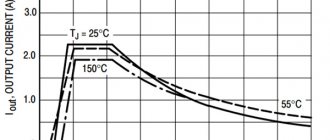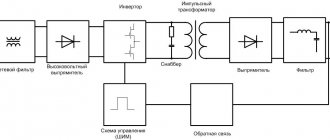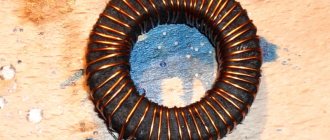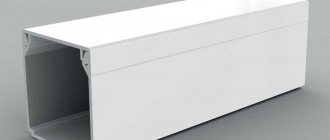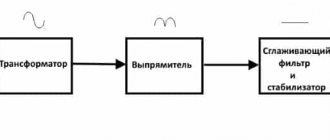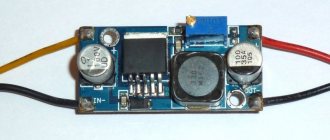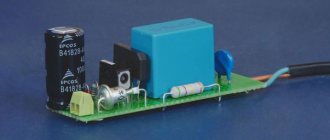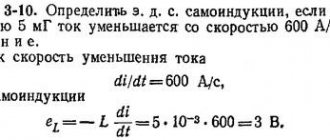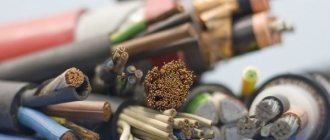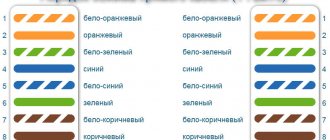Good day to all! In the last article, I talked about the phenomenon of electromagnetic induction and EMF that occurs during self-induction and mutual induction. Devices based on these phenomena and processes are called inductive elements (coils of oscillating circuits, transformers, chokes, reactors). One of the main parameters of these elements is the inductance L (also called the self-inductance coefficient). How to calculate this parameter will be discussed in this article.
To assemble a radio-electronic device, you can pre-make a DIY KIT kit using the link.
Reactance of the inductor.
When alternating current flows I
in a coil, a magnetic field creates an EMF in its turns, which prevents the current from changing. When the current increases, the EMF is negative and prevents the current from increasing; when it decreases, it is positive and prevents its decrease, thus resisting the change in current throughout the entire period.
U is formed at the terminals of the inductor in antiphase
, suppressing EMF, equal to it in amplitude and opposite in sign.
When the current passes through zero, the amplitude of the EMF reaches its maximum value, which forms a discrepancy in time between the current and voltage of 1/4 of the period.
U is applied to the terminals of the inductor
, the current cannot start instantly due to the counter-emf equal to
-U
, therefore the current in the inductance will always lag behind the voltage by an angle of 90°. The shift at the lagging current is called positive.
Let us write down the expression for the instantaneous voltage value u
based on the emf (
ε
), which is proportional to the inductance
L
and the rate of change of current:
u = -ε = L(di/dt)
. From here we express the sinusoidal current.
Integral of the function sin(t)
will be
-cos(t)
or an equal function
sin(t-π/2)
.
The differential dt
of the function
sin(ωt)
will leave the sign of the integral by the factor 1
/ω
.
As a result, we obtain an expression for the instantaneous value of the current with a shift from the voltage function by an angle π/2
(90°).
In this case, for the root-mean-square values of U
and
I,
As a result, we have a dependence of sinusoidal current on voltage according to Ohm’s Law, where in the denominator instead of R
expression
ωL
, which is the reactance:
The reactance of inductances is called inductive.
Manufacturing
Inductors can be purchased or made independently. Usually large items are purchased. Probably no one will want to wind the inductor for a fluorescent lamp themselves. Small windings for radio electronics are easy and fun to make with your own hands. Do-it-yourself skills will be useful when repairing coils or changing their operating parameters. To increase their inductance, special magnetic cores are used. They are made from a mixture of iron oxide with oxides of other metals.
Use other online calculators:
The insulated magnetic wire is wound directly onto a magnetic core covered with a thin layer of insulating paper. Before manufacturing, it is necessary to determine the parameters using special calculation formulas or programs. With their help, the size and type of core, the number of turns and the diameter of the wire will be determined.
Use other online calculators:
- Electric cable weight calculation
- Online calculation of current in a circuit
- Convert Watts to Amps
- Voltage loss calculation
- Online calculation of cable cross-section
Electromagnetic induction
Electromagnetic induction is the phenomenon of the occurrence of current in a closed conducting circuit when the magnetic flux passing through it changes.
The phenomenon of electromagnetic induction was discovered by Michael Faraday through a series of experiments.
Experience once. Two coils were wound on one non-conducting base in such a way that the turns of one coil were located between the turns of the second. The turns of the first coil were closed to a galvanometer, and the second were connected to a current source.
When the key was closed and current flowed through the second coil, a current pulse arose in the first. When the switch was opened, a current pulse was also observed, but the current through the galvanometer flowed in the opposite direction.
Experience two. The first coil was connected to a current source, and the second to a galvanometer. In this case, the second coil moved relative to the first. As the coil approached or moved away, the current was recorded.
Experience three. The coil was connected to a galvanometer, and the magnet was moved relative to the coil.
Here's what these experiments showed:
Why does induced current occur?
Current in a circuit can exist when external forces act on free charges. The work done by these forces to move a single positive charge along a closed loop is equal to electromotive force (EMF).
This means that when the number of magnetic lines through the surface limited by the contour changes, an emf appears in it, which is called the induced emf.
You are interested?
Today there are a lot of scientists interested in magnetism and magnetic phenomena. They study both the magnetic and electrical sides of substances, trying to identify patterns and synthesize powerful magnets with certain desired properties: for example, with a high melting point or superconductivity. All these materials can be used in a huge number of industries.
Let's take an example from the aerospace industry: rockets with ion engines, which create thrust by ejecting ionized gas from a nozzle, are promising for long-distance interstellar flights. The force of the push in such an engine depends on the temperature of the gas and the speed of its movement. Accordingly, in order to give the gas maximum force for acceleration, we need a very strong magnet that accelerates charged particles and also has a very high melting point in order not to melt when the gases exit the nozzle.
Built for high efficiency
Compact flat wire inductor designed to improve efficiency. Flat wire has a high winding ratio of 95%, so spools of flat wire have only 5% wasted space in the gaps between each winding, compared to 30% wasted space in spools of regular round wire. Figure 2 illustrates the space savings due to a high winding ratio with minimal waste in terms of unused space.
Rice. 2. Unused space in flat and round windings
The SRP extruded powdered iron core is molded directly onto the flat wire winding, providing the dual benefit of increasing the conductivity of the conductor when operating at high frequencies, and eliminating the wasted space that can occur with round wire designs.
Figure 3 shows the cross section of two inductors and the space-saving advantage of a flat wire with a powdered iron core.
Rice. 3 Pressed powdered iron core improves efficiency
This technology allows for smaller package size and greater efficiency, with inductance values as low as 47 µH currently available. SRP inductors have high saturation currents of up to 60 A, the values of which are related to the drop in inductance value. Compact cases occupy an area of 4.8 to 14.8 mm and have a height of 2 to 7 mm. Current ratings vary with temperature and range up to 46 A. Bourns continues to expand its range of SRP inductors. The newly released SRP4020FA is 4.1 mm wide and 1.9 mm high and provides inductance in the range of 0.47...4.7 µH and current up to 13.2 A. Another recently released inductor SRP7030CA is 7.8 mm wide and 2.9 mm high, providing inductances of 1...8.2 µH at current levels up to 21.8 A. Future plans for the development and release of SRP series inductors include larger components for higher current values, for example, an inductor with a footprint of 20 mm2, which will provide a saturation current of 150 A. It is also planned to produce smaller inductors with a base area of up to 3 mm2 at a saturation current of 10 A.
The program allows you to calculate the following types of inductors:
- Single round turn
- Single-layer turn to turn. Two options can be chosen as initial parameters when calculating the coil:
- The diameter of the frame and the diameter of the wire are known, and the winding length is calculated.
- The frame diameter and winding length are known, the wire diameter is calculated
- Single Layer Pitch Coil
- Coil with non-round turns
- Multilayer coil You can choose two options as initial parameters when calculating the coil:
- The diameter of the frame, the length of the winding and the diameter of the wire are known. The number of turns is calculated, and at the same time the thickness of the coil is determined, its ohmic resistance to direct current and the approximate length of the wire for winding (“how much should be cut”).
- The diameter of the frame, the winding length and the maximum ohmic resistance of the coil are known. The number of turns is calculated, and at the same time the thickness of the coil, the required minimum wire diameter and the approximate length of the wire for winding are determined.
- Toroidal single layer coil
- Ferrite ring coil
- Coil in armored core (Ferrite and carbonyl)
- Thin Film Coil (Flat coil on PCB with round and square turns and as a single straight conductor)
More about Coil32...
Quite often, a radio amateur is faced with the question: “How to calculate the inductance of a coil?” Coils are used in high-frequency communications equipment, and in the design of acoustic systems, and even looking at the computer motherboard, you will find inductive elements there too. Using the Coil32 program you can quickly calculate the inductance of the coil. The program takes into account the most common options for coil frames. It is possible to calculate a frameless coil in the form of a single turn, on frames of various shapes, on ferrite rings and in armor cores, as well as a flat printed coil with round and square turns. For the calculated coil, you can “without leaving the cash register” calculate the capacitance of the capacitor in the oscillating circuit.
What are the advantages of the program over analogues?
- The program calculates the inductance of many types of coils. You can choose the best option, or recalculate the coil to fit the existing frame.
- The results of all calculations are displayed in a text field, from where they can be saved to a file. In the future, you can view them so as not to recalculate again. You can open this file in MS Word and print it.
- It is possible to calculate the quality factor for radio frequency single-layer inductors.
- The main parameters of the oscillatory circuit for a single-layer coil are calculated
- You can calculate the wire length for winding a single-layer, multi-layer and ferrite ring coil
- For coils in armor cores, it is possible to choose from several standard ones, which allows you to calculate the coil with a few clicks of the mouse.
- For flat coils on a printed circuit board, the program will suggest the optimal dimensions to achieve the highest quality factor.
- On the Internet you can often find programs for calculating inductance that run under DOS; I think there is no need to talk about the advantages of the Windows interface.
- The program has the ability to expand functionality using additional plugins for calculating inductances
- The program has a multilingual interface and skins; additional sets of skins can be found on.
The program is distributed in the "Portable" style and does not have an installer. To install the program, unpack the program archive into any directory and run the Coil32.exe file. If you constantly work with the program, it is advisable to create a special folder for it and place the Coil32.exe shortcut on your desktop.
How to Calculate the Inductance of a Coreless Multilayer Coil Using a Ruler and an Ohmmeter
- RADIOLOTSMAN magazine, January 2012
- Petr Demchenko, Lithuania
- EDN
- The article shows how to calculate the inductance of a coreless multilayer coil, knowing only its dimensions and DC resistance
- If the coil dimensions are expressed in millimeters, its inductance in microhenry can be calculated using the formula:
Where
- D – average diameter of the coil,
- h – coil height,
- g – depth (winding thickness) of the coil,
- N – number of turns (Figure 1).
| Picture 1. | Knowing the dimensions and number of turns of the coil, you can calculate its inductance. |
If the number of turns is unknown, the inductance can still be calculated using the DC resistance value of the winding. It is assumed that the coil is wound neatly, turn to turn, with cylindrical enameled wire (Figure 2). In this case, an approximate expression for the number of turns will be as follows:
- where d is the diameter of the wire.
- However, we will assume that the diameter is unknown to us.
What parameters does the coil have?
Its design depends on where the inductive element will be used and at what frequency it will operate. There are general parameters:
- L – inductance;
- R sweat – loss resistance;
- Q – quality factor;
- its resonance and parasitic capacitance;
- coefficients TKI and TKD.
Inductance (self-inductance coefficient) L is the main electrical characteristic of the element, which shows the amount of energy accumulated by the inductor when current flows. The greater the inductance, the higher the energy in the coil. Unit of measurement L – 1 Hn.
When current and magnetic field interact in the winding, harmful phenomena occur. They contribute to the occurrence of losses, which are denoted by R sweat. The loss formula looks like:
R sweat = rω + rd + rs + re.
The terms of the formula are losses:
- rω – in wires;
- rd – in dielectric;
- rs – in the core;
- re – for eddy currents.
As a result of such losses, the impedance of an inductive two-terminal network cannot be called entirely reactive.
The quality factor of a two-terminal network is determined by the formula:
Q = ω*L/R sweat,
where ω*L = 2π*L – reactance.
When winding the turns of an element, unnecessary capacity appears between them. Because of this, the choke turns into an oscillatory circuit with its own resonance.
TCI is an indicator describing the dependence of L on Т0С.
TKD is an indicator that describes the dependence of the quality factor on T0C.
Information. Changes in the main parameters of an inductive two-terminal network depend on the TCI, TKD coefficients, as well as on time and humidity.
Self-induction
Let's imagine any electrical circuit whose parameters can be changed. If we change the current strength in this circuit - for example, we turn up the rheostat or connect another current source - the magnetic field will change. As a result of this change, an additional induced current will arise in the circuit due to electromagnetic induction, which we discussed above. This phenomenon is called self-induction, and the resulting current is called self-induction current.
Magnetic flux formula for self-induction
F = LI
Ф - own magnetic flux [Wb]
L - circuit inductance [H]
I - current strength in the circuit [A]
Self-induction is the occurrence of an EMF in a conducting circuit, created as a result of a change in current strength in the circuit itself.
Self-induction is somewhat reminiscent of inertia: just as in mechanics it is impossible to instantly stop a moving body, so the current cannot instantly acquire a certain value due to self-induction.
Let's imagine a circuit consisting of two identical lamps connected in parallel to a current source. If we connect a coil in series with the second lamp in this circuit, then when the circuit is closed, the following will happen:
When the circuit is opened, the current strength quickly decreases, and the resulting self-induction emf prevents the decrease in magnetic flux. In this case, the induced current is directed in the same way as the original one. The self-induced emf can be many times greater than the external emf. This is why light bulbs burn out so often when the lights go out.
Self-induced emf
ξis — self-induction emf [V]
ΔФ/Δt — rate of change of magnetic flux [Wb/s]
ΔI/Δt - rate of change of current in the circuit [A/s]
L - inductance [H]
The minus sign in the formula for the law of electromagnetic induction indicates that the induced emf prevents the change in magnetic flux, which causes the emf. When solving calculation problems, the minus sign is not taken into account.
Capacitor reactance.
The electric current in a capacitor is a part or a set of processes of its charge and discharge - the accumulation and release of energy by the electric field between its plates.
In an AC circuit, the capacitor will charge to a certain maximum value until the current reverses direction. Consequently, at the moments of the amplitude value of the voltage on the capacitor, the current in it will be equal to zero. Thus, the voltage across the capacitor and the current will always have a time difference of a quarter period.
As a result, the current in the circuit will be limited by the voltage drop across the capacitor, which creates an alternating current reactance that is inversely proportional to the rate of change of current (frequency) and the capacitance of the capacitor.
If a voltage U
, the current will instantly start from the maximum value, then decrease to zero. At this time, the voltage at its terminals will increase from zero to maximum. Consequently, the voltage on the capacitor plates lags the current in phase by an angle of 90 °. This phase shift is called negative.
The current in a capacitor is a derivative function of its charge i = dQ/dt = C(du/dt)
.
The derivative of sin(t)
will be
cos(t)
or an equal function
sin(t+π/2)
.
Then for sinusoidal voltage u = Uampsin(ωt)
we write the expression for the instantaneous current value as follows:
i = UampωCsin(ωt+π/2)
.
From here we express the ratio of the root-mean-square values.
Ohm's law dictates that 1 /ωC
is nothing more than reactance for a sinusoidal current:
The reactance of a capacitor in technical literature is often called capacitive. It can be used, for example, in organizing capacitive dividers in alternating current circuits.
Online reactance calculator
You need to enter the values and click in the table. When switching multipliers, the result is automatically recalculated.
| Capacitance reactanceXC = 1 /(2πƒC) | Inductance reactanceXL = 2πƒL |
Calculate capacitance or inductance for reactance:
| Capacity calculation: C = 1 /(2πƒXC) | Inductance calculation: L = XL /(2πƒ) |
Similar pages with calculations: Calculate impedance. Calculate the resonance frequency of the LC oscillating circuit. Calculate reactive power and compensation.
Calculation formulas
It's time for us to move on to the main topic of the article. We will start by talking about how to calculate the inductance of a coil without a core. This is the simplest type of calculation. But there are some subtleties here too. Let us take, for simplicity, a coil whose winding lies in one layer. For it, the calculation of a single-layer inductor is valid:
L=D2*n2/(45D+100l).
Here L is the inductance, D is the coil diameter in centimeters, n is the number of turns, l is the winding length in centimeters. A single-layer coil assumes that the winding thickness will be no more than one layer, which means that the calculation of a flat inductor is valid for it. In general, most formulas for calculating inductances are very similar: significant differences are only in the coefficients for the variables in the numerator and denominator. The simplest thing here is to calculate the inductance of a coil without a core.
The formula for calculating the inductance of a coil with a large number of turns is also of interest:
L=0.08*D2*n2/(3*D+9*b+10*c).
Here b is the width of the wire, c is its height. This formula is effective for calculating a multilayer inductor. It is used in practice a little less often than the one discussed below.
The most relevant, perhaps, will be the calculation of the inductance of the coil with the core. There is a special formula that shows that this inductance is determined by the material from which the core is made, or more precisely, by its magnetic permeability. This formula looks like this:
L=m*m0*n2*S/l, where m is the magnetic permeability of the core material, m0 is the magnetic constant (it is equal to 12.56·10-7 H/m), S is the cross-sectional area of the coil, l is the winding length .
The calculation of the turns of an inductor is very simple: this is the number of layers of conductor wound around the core.
We have dealt with the formulas, and now a little about where exactly these formulas and calculations can be useful to us.
What parameters does the coil have?
Its design depends on where the inductive element will be used and at what frequency it will operate. There are general parameters:
- L – inductance;
- R sweat – loss resistance;
- Q – quality factor;
- its resonance and parasitic capacitance;
- coefficients TKI and TKD.
What does inductance depend on?
Inductance (self-inductance coefficient) L is the main electrical characteristic of the element, which shows the amount of energy accumulated by the inductor when current flows. The greater the inductance, the higher the energy in the coil. Unit of measurement L – 1 Hn.
When current and magnetic field interact in the winding, harmful phenomena occur. They contribute to the occurrence of losses, which are denoted by R sweat. The loss formula looks like:
R sweat = rω + rd + rs + re.
The terms of the formula are losses:
- rω – in wires;
- rd – in dielectric;
- rs – in the core;
- re – for eddy currents.
As a result of such losses, the impedance of an inductive two-terminal network cannot be called entirely reactive.
The quality factor of a two-terminal network is determined by the formula:
Q = ω*L/R sweat,
where ω*L = 2π*L – reactance.
When winding the turns of an element, unnecessary capacity appears between them. Because of this, the choke turns into an oscillatory circuit with its own resonance.
TCI is an indicator describing the dependence of L on Т0С.
TKD is an indicator that describes the dependence of the quality factor on T0C.
Information. Changes in the main parameters of an inductive two-terminal network depend on the TCI, TKD coefficients, as well as on time and humidity.
Types of RFID tags
There are three types of RFID tags: active, passive and semi-passive. Active and semi-passive tags use batteries to power their chips. They are more expensive than passive tags, but they have more useful properties. In particular, active tags use their own power source to power a transmitter that creates electromagnetic waves, which can significantly increase the communication range between the tag and the reader.
Active tags
Because active tags contain batteries, they can store more information and provide a longer communication range. They can transmit a radio signal that can be received at a distance of up to 100 meters. Due to this feature, active RFID tags are convenient for organizing the accounting of material resources. The battery life of active RFID tags is up to 10 years. Due to the design of tags, they are usually not replaceable, and at the end of their service life the entire tag must be replaced.
Active RFID tags can operate in two modes: transponder and beacon. To increase battery life, the transponder tag “listens” to the signal from the reader and turns on the transmitter only in cases where such a signal is available. On the other hand, tag beacons turn on the transmitter, for example, once every 10 seconds, trying to send the necessary information. Active tags often contain various sensors and allow you to read information about humidity levels, temperature, pressure and other environmental parameters. The design of active RFID tags is often much more complex than the design of passive tags - which is why active tags are more expensive than passive ones.
Passive tags
An NFC key for a hotel room, which simultaneously functions as a general light switch and various household appliances. To turn on the power, the guest must enter the room and insert the key card into the switch
Unlike active RFID tags, passive tags are very simple and consist of just two components: a coil-shaped antenna and an integrated circuit chip. The reader activates its coil, which sends electromagnetic energy to the tag's coil. If the tag is in the read range, both coils form a transformer, which provides an inductive coupling used to communicate and power the tag itself - the same principle that wireless charging works on smartphones. The alternating current taken from the tag antenna is rectified and used to power the tag chip, which sends a signal with useful information back to the coil. This information is read by the reader coil.
There are two types of passive RFID tags: RFID stickers and hard type tags. Thanks to a layer of adhesive on the back of the tag, they can be placed anywhere, for example, on library books, to organize the accounting of the library collection. “Hard” tags are reliable in operation and are made of glass, plastic, metal, ceramics, rubber and other materials. Passive RFID tags are thinner and cheaper than active tags and last a lifetime because they do not have a battery. Passive low frequency RFID tags are used for microchipping animals. They are enclosed in a glass capsule slightly larger than a grain of rice and can be used on any cat or dog whose owners are concerned about the possible loss of their pets.
Payment terminal of the PRESTO public transport fare payment system in Ontario, Canada
Semi-passive tags
Semi-passive RFID tags are typically used to monitor sensors or the operation of various equipment by reading various output data, such as the operation of switches (on-off) or valves (open-closed). The principle of their operation is similar to the principle of passive tags. The signal from the reader causes the tag to respond. The battery of a semi-passive tag is used to power electronic circuits that are used to read information from various sensors even if the tag is not being interrogated by the reader. If the tag sends information to the reader, it transmits not only information from the sensors, but also its serial number.
Selecting a magnetic core
| Here is a selection of materials for your attention: TO design of power supplies and voltage converters Development of power supplies and voltage converters. Typical schemes. Examples of finished devices. Online payment. Opportunity for authors P practice of electronic circuit design. The art of device design. Element base. Typical schemes. Examples of finished devices. Detailed descriptions. Online payment. Opportunity for authors |
If the operating frequency of the device is up to 3 kHz, then a magnetic core made of transformer iron is suitable. If the frequency is above 7 kHz, then preference should be given to ferrites. At frequencies of 3 - 7 kHz, both iron and ferrite cores can be used. But the efficiency of devices at these frequencies is usually lower than at others, since here iron is already losing its attractiveness, losses are increasing, and ferrites cannot yet reveal their potential. Up to 150 kHz for a choke with a gap (and the vast majority of chokes are made with a gap), the grade of ferrite does not matter. Nothing depends on the magnetic permeability of ferrite in the calculation. At frequencies above 150 kHz, special high-frequency grades of ferrites should be used.
The calculation for iron and ferrites at different frequencies has only one difference. For iron, the maximum induction is selected around 1 Tesla. For ferrites: at a frequency up to 100 kHz - 0.3 T, at a frequency above 100 kHz - 0.1 T. If you want to reduce losses due to magnetization reversal of the magnetic circuit, the maximum induction is selected even less.
The wire is selected based on a current density of 5A / 1 sq. mm section. This is worse than European standards, but, as practice has shown, it is quite acceptable. If the current is small (less than 0.25 A), then the inductor is wound with one wire of the required diameter, if more than 0.25 A, then with a bundle of 0.25 mm wires (to eliminate the skin effect). One such wire works well at currents up to 0.25 A.
By checking whether there is enough space for the winding in the magnetic circuit window, we believe that the filling density of the window will not exceed 50%. It is possible to lay the wire more tightly only on a machine. We have never been able to obtain better density manually.
Benefits of Bourns inductors
Bourns has been a leader in the inductor industry for decades. Bourns is a trusted name and the company's products should be kept in mind when developing new DC/DC converters or other converter designs that require surface mount components. The likelihood of finding the component you need in a product line of 2,000 items is very high, and the product you find will probably exceed your requirements.
However, keep in mind that core loss calculations for a particular application may depend on factors such as magnetic flux density, core loss, and temperature variation. Bourns specialists and the company’s software products will always help with calculations and selection of the right product.
Flat wire chokes of the SRP03\4\5\6* series are designed for applications that require dimensions of the final product, especially its height. The inductors of this family belong to the low-profile class - their height does not exceed 2 mm, which is a competitive advantage when choosing coils for DC/DC used in portable and miniature electronics. At the same time, SRP03\4\5\6* chokes make it possible to obtain a fairly high level of inductance - up to 10 μH - and high operating currents - up to 15.5A. The main parameters of this family are presented in Table 1.
Table 1. SRP03\4\5\6* series chokes with flat wire
| Series name | Dimensions, mm | Inductance range, µH. | Current range, A |
| SRP0310 | 3.4 x 3.1 x 1 | 0.47…4.7 | 1.8…5.6 |
| SRP0312 | 3.4 x 3.1 x 1.2 | 0.47…4.7 | 1.9…6.6 |
| SRP0315 | 3.4 x 3.1 x 1.5 | 0.47…4.7 | 2.3…9 |
| SRP0320 | 3.4 x 3.1 x 2 | 0.47…4.7 | 2.2…7.4 |
| SRP0410 | 4.4 x 4.1 x 1 | 0.47…10 | 1.4…5.2 |
| SRP0412 | 4.4 x 4.1 x 1.2 | 0.47…10 | 1.7…7.6 |
| SRP0415 | 4.4 x 4.1 x 1.5 | 0.47…10 | 1.9…9.3 |
| SRP0420 | 4.4 x 4.1 x 2 | 0.47…10 | 1.8…10.5 |
| SRP0510 | 5.4 x 5.1 x 1 | 0.47…10 | 1.6…5 |
| SRP0512 | 5.4 x 5.1 x 1.2 | 0.47…10 | 2.1…8.3 |
| SRP0515 | 5.4 x 5.1 x 1.5 | 0.47…10 | 2.4…9.5 |
| SRP0520 | 5.4 x 5.1 x 2 | 0.47…10 | 2.4…12.5 |
| SRP0610 | 7.1 x 6.7 x 1 | 0.47…10 | 2…4.7 |
| SRP0612 | 7.1 x 6.7 x 1.2 | 0.47…10 | 2.7…7.7 |
| SRP0615 | 7.1 x 6.7 x 1.5 | 0.47…10 | 3…12,5 |
| SRP0620 | 7.1 x 6.7 x 2 | 0.47…10 | 3.6…15.5 |
The SRP*FA and SRP*CA series flat wire chokes are designed for high current demanding applications, such as DC/DC powering CPU\GPU\ARM, where operating currents can reach tens of amperes. The core of the chokes of this family is made of metal-composite material (rather than ferrite), which makes it possible to obtain ultra-high saturation currents that do not depend on temperature conditions. The main parameters of this family are presented in Table 2.
Table 2. SRP*FA and SRP*CA series chokes with flat wire
| Series name | Dimensions, mm | Inductance range, µH | Current range, A |
| SRP4018FA | 4.1 x 4.1 x 1.8 | 0.33…1.2 | 9.5…15 |
| SRP4020FA | 4.1 x 4.1 x 1.9 | 0.47…4.7 | 5.1…13.2 |
| SRP4030FA | 4.1 x 4.1 x 2.8 | 0.9…6.8 | 4…11.2 |
| SRP5050FA | 5.5 x 5.3 x 4.8 | 5.6…8.2 | 6.1…7.2 |
| SRP6060FA | 6.6 x 6.4 x 5.8 | 2.2…22 | 5…14 |
| SRP5030CA | 5.5 x 5.3 x 2.9 | 0.15…4.7 | 5.9…22.2 |
| SRP6030CA | 6.6 x 6.4 x 2.9 | 0.18…4.5 | 7…32 |
| SRP6050CA | 6.6 x 6.4 x 4.8 | 1…4.7 | 8.5…20 |
| SRP7030CA | 7.8 x 7.6 x 2.9 | 1…8.2 | 5.9…21.8 |
| SRP1510CA | 16.5 x 15.5 x 9.7 | 4.7…33 | 18.7…43 |
| SRP1513CA | 16.5 x 15.5 x 12.7 | 4,7…33 | 19…44 |
| SRP1580CA | 16.5 x 15.5 x 7.7 | 1…5.3 | 35…80 |
The PQ26* series flat wire ferrite core chokes are designed for high current applications that require very low active losses. A distinctive feature of this family is the extremely low value of the DCR parameter (direct current resistance), which does not exceed the level of 2 mOhm. It is with the use of chokes of this family that it is possible to build a DC/DC converter with maximum efficiency and minimal losses. The main parameters of this family are presented in Table 3.
Table 3. PQ26* Series Flat Wire Chokes
| Series name | Dimensions, mm | Inductance range, µH | Current range, A |
| PQ2614BHA | 28 x 28 x 16 | 2.2…33 | 30 |
| PQ2614BLA | 28 x 28 x 16 | 1…33 | 30 |
| PQ2617BHA | 28 x 28 x 19 | 3.3…33 | 28 |
Equivalent circuit of a real inductor
Each inductor can be represented as an equivalent circuit.
This scheme consists of elements:
- Rw – resistance of the winding with leads;
- L – inductance;
- Cw – parasitic capacitance;
- Rl – loss resistance.
When manufacturing an inductive element, they strive to reduce the amount of loss resistance and parasitic capacitance. When the coil operates at a low frequency, the resistance of its winding Rw is taken into account. Large currents operate at such frequencies.
Throttle equivalent circuit
A correctly calculated inductor will have a high quality factor (180-300) and stable operation under the influence of external conditions (temperature and humidity). Knowing the methods of various winding and pitch manipulation, you can reduce the influence of parasitic factors.
Inductive resistance Wikipedia
Reactance
(reactance) - electrical resistance caused by the transfer of energy by alternating current to an electric or magnetic field (and vice versa).
Reactance determines the imaginary part of the total resistance (impedance):
Z=R+jX{\displaystyle Z=R+jX}, where Z{\displaystyle Z} is the total resistance or impedance, R{\displaystyle R} is the value of active resistance, X{\displaystyle X} is the value of reactance, j{\displaystyle j} is the imaginary unit.
Depending on the sign of the value X{\displaystyle X} of any element of the electrical circuit, we speak of three cases:
- X>0{\displaystyle X>0}
- the element exhibits inductive properties. - X=0{\displaystyle X=0}
- the element has purely active resistance. - X<0{\displaystyle X<0}
- the element exhibits capacitive properties.
The value of reactance can be expressed through the values of inductive and capacitive reactance:
X=XL−XC{\displaystyle X=X_{L}-X_{C}}
Inductive reactance
(XL{\displaystyle X_{L}}) is caused by the occurrence of self-inductive emf in an element of the electrical circuit. A change in current and, as a consequence, a change in its magnetic field causes a self-induction emf that prevents a change in this current. The magnitude of inductive reactance depends on the inductance L{\displaystyle L} of the element and the angular frequency ω{\displaystyle \omega } of the flowing current: XL=ωL=2πfL{\displaystyle X_{L}=\omega L=2\pi fL} Capacitive reactance
(XC{\displaystyle X_{C}}). The value of capacitance depends on the capacitance of the element C{\displaystyle C} and also the frequency of the flowing current f{\displaystyle f}: XC=1ωC=12πfC{\displaystyle X_{C}={\frac {1}{\omega C}} ={\frac {1}{2\pi fC}}} Here ω{\displaystyle \omega } is the cyclic frequency equal to 2πf{\displaystyle 2\pi f}.
Connection methods
As with other components, self-induction elements can be connected in a variety of ways. The inductance of the coils depends on the type of connection.
In calculations, the letter designation L is used, i.e. Lenz. They need to be understood as the energy of the magnetic field of a specific coil.
Parallel connection
For many elements, the inductance formula looks like this:
For two it is much simpler:
In parallel connections, plus is connected to plus, and minus to minus. Wherein:
All elements have the same voltage. The current strength at the point of contact is equal to the current strength of the individual elements.
Serial connection
The essence of a serial connection is connecting plus to minus. The calculation formula is much simpler: just add up the indicators of all the elements of the chain:
Inductor Calculator
You can calculate the inductance yourself or perform an online calculation using a special calculator. The most commonly used program for automatic calculation is Coil32. You can copy it for free from the website of the same name or use an online calculator. Using this program is quite simple.
When working with it, you first need to select the type of product (single-layer or multilayer, with or without a ferrite core, other options are possible). By specifying in the calculator the calculation of geometric parameters, wire diameter, number of turns, core properties, you can use the program to obtain the expected inductance of the product. To obtain the required value, you can change the number of turns and the diameter of the wire in the calculations.
The assembled product can be checked according to the calculated parameters using a tester for compliance with the required parameters. Such a device is called an LC tester. It measures the inductance of the coils and the capacitance of the capacitors. If the obtained parameters deviate from the specified value, you can increase or decrease the number of turns of wire on the product.
If desired, you can independently calculate the inductance of the coil without or with a core. There is no single formula; they are strictly individual for each case. In general, they are directly proportional to the number of turns and the diameter of the turns. For example, the calculation of a single-layer cylindrical winding is performed using the formula:
Calculating the inductance of a coil with a core is more complex. With its addition, the inductance value increases greatly. In the calculations, parameters of the magnetic properties of the core are added to the formula. Even more complex are the formulas for calculating multilayer coils or toroidal coils. For rare or initial use, it is best to use special calculators. The resulting calculations can be checked using the formulas manually. In any case, after manufacturing, you can check the parameters of the assembled product and, if necessary, change them.
What is an inductor?
We come across these objects all the time, but we hardly attach any special meaning to them. This is commonplace for us. In fact, inductors are found in almost every device today, but the most striking example of their use is transformers. If you think that transformers are only found in power substations, then you are very mistaken: your laptop or smartphone charger is also a kind of transformer, only smaller than those used in power plants and distribution substations.
Any inductor consists of a core and a winding. The core is a rod of dielectric or ferromagnetic material on which the winding is wound. The latter is most often made from copper wire. The number of turns of the winding is directly related to the magnitude of the magnetic induction of the resulting coil.
Now, before we consider the calculation of the inductance of coils and the formulas necessary for it, let's talk about what parameters and properties we will calculate.
RFID devices implanted into the human body
Human RFID tags are usually a passive RFID transponder containing an integrated circuit chip (colloquially called a chip by lazy journalists) in a glass capsule. The tags are implanted subcutaneously in a person's arm or other part of the body and usually contain a unique identification number that can be linked to information in a database containing information about identity, legal problems, medical history, medications taken and so on. VeriChip Corporation began producing RFID implants back in 2002, and in 2004 their devices were certified by the US Food and Drug Administration (FDA).
Future applications of passive RFID tags implanted in the human body:
- Providing data for electronic systems for storing medical information about patients
- Monitoring patients in hospitals
- Monitoring the time patients take medications in hospitals
- Medical Device Management
- Possibility of retrieving medical information during emergency medical care
- Helping disoriented patients with Alzheimer's disease
- Personnel location control
- Search for lost children
- Convenience of opening doors, managing printers, unlocking computers in offices
Of course, there are many problems associated with human implants, including the possible occurrence of tumors at the site of injection of the tracer, unwanted migration of the tracer in the body; possible incompatibility of tags with devices operating on the principle of magnetic resonance, as well as risks associated with security and privacy.
Form
In the picture on the left there is an W-shaped core, on the right there is a U-shaped one. A
- thickness of the core,
B
- height of the core window,
C
- width of the core window,
D
- width of the tooth.
When making a gasket in the core, do not forget that its thickness should be half the calculated gap, since the magnetic line in the W and U-shaped cores crosses it twice.
(read more...) :: (to the beginning of the article)
| 1 | 2 |
:: SearchSafety :: Help
Unfortunately, errors are periodically found in articles; they are corrected, articles are supplemented, developed, and new ones are prepared. Subscribe to the news to stay informed.
If something is unclear, be sure to ask!Ask a question. Discussion of the article. messages.
Good day. Is it possible to apply the method to calculate a three-phase motor choke (inverter + motor)? What are the features of manufacturing such chokes (for example, take three transformers, etc.)? Read the answer...
Good health! What formula is used to trigger a warning about insufficient core power? Read the answer...
Hello! I am assembling a welding inverter according to the circuit from Negulyaev’s book (resonant half-bridge), and I tried to determine the inductance of the resonance choke using your online calculators, but you need to substitute a known inductance value into them (and where, by the way, can you get it from if there are no measuring instruments) and receive turns. But I need it the other way around. This is necessary to try Read the answer...
In the calculation of the throttle, namely the determination of the gap, there is a discrepancy of about 30% downwards. How can you comment on this? Read the answer...
At a current of 50-60 A on the W-shaped core, the turns located in close proximity to the gap begin to char. Any piece of iron inserted into the gap simply melts. This is some kind of induction. Practice suggests that you need to remove the turns as far as possible from the gap. In such cases, preference is given to P - arr. cores. Is it so? Read the answer...
In addition to the incomprehensible expression in the gap formula, it is also unclear why other sources seem to give some other calculations? For example, in this book, as I understand it, there is some general case of calculation, or for some reason they are different. Read the answer...
Hello. What does the expression in the formula for the size of the gap in the core mean? Read the answer...
Thanks for the material! Is '0.25mm wire' the diameter or cross-sectional area? Read the answer...
Hello. To assemble a pulsed sinusoidal voltage source, I calculate the parameters of inductor L1. The existing W-shaped core 20*28 N87 is small in size, as indicated by the online calculation. But the program does not have the ability to select the required size based on the required parameters. To go and buy what you need. Tell me either the required overall dimensions or the program for selection Read the answer...
Hello, could you help with calculating the inductor for the circuit published on your website: https://hw4.ru/circuitry-switching-sinus
Available is a wire with a diameter of 0.5 mm and ferrite rings B64290L0651X03 https://static.advonics.com/content/pdfs/221/7092193.pdf
Size R22.1×13.7×12.5(mm) Material T38 Initial permeability 10,000
Nominal you Read the answer...
More articles
Making a choke, an inductor with your own hands, yourself, by yourself... Calculation and production of an inductor, a choke. Typical electronic circuits...
Power powerful pulse transformer, choke. Winding. Make... Techniques for winding a pulse inductor / transformer....
Switching power supply. With my own hands. Homemade. Do. Labo... Scheme of a switching power supply. Calculation for different voltages and currents….
Design (design and calculation) of power supplies and converters... Development of power supplies and voltage converters. Typical schemes. Note...
Checking the inductor, inductor, transformer, winding, electrical... How to check the inductor, transformer windings, inductor, electrical...
Practice of electronic circuit design. Electronics tutorial... The art of device development. Element base of radio electronics. Typical schemes...
Push-pull switching power supply. Online payment. Form. Suppressed... How to calculate a push-pull switching voltage converter. How to suppress p...
Boost switching power supply. Online payment. Form. Suppressed... How to calculate a boost switching voltage converter. How to suppress pu...
Calculation of coil parameters
We have to consider different options when making calculations. The calculation of inductance depends on the initial data and the specified final parameters.
Calculation of L depending on the given design
If the initial parameters are: w, D of the frame and the length of the wound wire, then the formula for calculation is:
L = 0.01*D*w2/(l/D) + 0.46,
Where:
- D – frame diameter, cm;
- w – number of turns;
- l – winding length, cm;
- L – inductance, µH.
Substituting numerical values into the formula, the value of L is obtained.
Calculation of the number of turns by inductance
Knowing frame D and L, the number of turns in the coil is calculated, the formula looks like:
w = 32*√(L*D),
Where:
- L – inductance, µH;
- D – frame diameter, mm.
If the length of the conductor wound in a row and its diameter are taken as the initial parameters, then the number of turns is found using the formula:
w = l/d,
Where:
- l – winding length, mm;
- d – wire diameter, mm.
Wire diameter measurements are carried out with a ruler or caliper.
Calculation of inductance of a straight wire
When planning to find L of a round straight conductor, we turn to the approximate formula:
L = (μ0/2π)*l*( μe*ln(l/r) + 1/4* μi,
Where:
- μ0 – magnetic constant;
- μe – relative magnetic permeability (RMP) of the medium (for vacuum – 1);
- μi – conductor OMF;
- l – wire length;
- r is the radius of the wire.
The formula is valid for a long conductor.
Calculation of single-layer winding
Single-layer chokes without a core can be easily and quickly calculated using an online calculator, in the window of which you can enter all known characteristics, and the program will display the value L.
Calculations are also carried out manually, using a mathematical expression. It looks like:
L = D2*n2/45D + 100*l,
Where:
- D – coil diameter, cm;
- l – length of the wound wire, cm;
- n – number of turns.
The formula is suitable for calculating L chokes without ferrite cores.
Single layer coil turn to turn
Core choke
If there is a core, its size and shape should be taken into account. In the case of identical coils, the inductance is greater in the one located on the core.
Calculation of single-layer winding with core
Multilayer winding
Features of the calculation with this method of winding wire are that you need to take into account its thickness. The formula for a coreless choke is:
N²=(L*(3Dk+9l+10t))/0.008Dk²,
Where:
- Dk – total diameter (diameter of frame and winding);
- t – layer thickness;
- l is the length of the wound wire.
All values are substituted in mm, the value of L is in µH.
Multilayer winding
RFID and NFC - what's the difference
So what are RFID and NFC? Both are closely related methods of transmitting information that have numerous areas of application. Examples include inventory management, contactless payments, exchange of contact information, photos and videos, electronic payment of toll roads and bridges, and much more. Radio Frequency Identification (RFID) is a technology that uses electromagnetic fields to identify and track the movement of tags attached to various objects. Near-Field Communication (NFC) is a technology based on existing radio frequency identification standards that allows communication between two electronic devices located nearby at a distance of less than 10 cm. Typically these are two smartphones, or a reader and a smartphone, or a smartphone and an RFID tag. To organize communication using NFC, a range with an average frequency of 13.56 MHz is used. The same frequency is standardized for RFID devices.
RFID tag antenna chip and coil
Radio Frequency Identification (RFID)
Allows one-way or two-way communication between RFID tags and the RFID receiver. Tags can be passive (without their own power source), active (with their own battery) and semi-passive (also with a battery). Receivers have their own power supply and can be passive (operating in tag-reading mode only) and active (they can not only read, but also transmit information to tags). RFID tags can be read over long distances, up to 200 meters without a direct line of sight between the reader and the tag. Therefore, they can be used, for example, to handle baggage at the airport. RFID uses several radio frequency bands, shown in the table below. Communication between the reader and tags is carried out using standardized protocols. Different protocols are used for different frequency ranges.
| RFID frequency range | Scan distance | Examples of technology application |
| 120-150 kHz (low frequencies, LF) | up to 10 cm | Automotive immobilizers, RFID tags for animals, industrial applications |
| 13.56 MHz (treble, HF) | Up to 1 m | Product movement tracking, smart tags, near-field communication (NFC), access control to premises |
| 433 MHz (ultra high frequencies, UHF) | 1–150 m (active tags) | Monitoring the movement of personnel and vehicles, monitoring sensor data |
| 860–960 MHz (ultra high frequencies, UHF) | 1–12 m (depending on tag type) | Tracking the movement of boxes and pallets with cargo, accounting, control and registration in industry, tags for transmitting information read from sensors, identification in livestock farming, anti-theft and anti-theft devices |
| 2.45 GHz (UHF) | 1–100 m (active tags) | Industrial applications, key tags, sensor tags, wrist strap tags for people tracking |
| 3.1–10 GHz (ultra high frequencies, microwave) | Up to 200 m (active tags) | Real-time product monitoring systems, accounting of material assets |
Near Field Communication (NFC)
operates in the 13.56 MHz frequency range and is an extension of the RFID standard and protocols. In this regard, many of the physical properties of NFC coincide with the properties of high-frequency RFID devices. NFC allows two-way communication between two closely located (less than 5 cm apart) electronic devices, one of which is usually a smartphone, and the other is a smartphone, payment card reader, or NFC tag. NFC combines a smart card interface and a smart card reader into one device. Both RFID and NFC high frequency communications operate in the same frequency range with a center frequency of 13.56 MHz. Unlike RFID, which works well at distances of 100 m or more, NFC works at a maximum distance of only 10 cm.
Examples of communication between two mobile phones include exchanging files using the Android Beam app, pairing between two Bluetooth devices and establishing a connection between them without the need for passwords. There are many examples of communication between a mobile phone and a tag that can be easily programmed from the phone: calling a social networking site, launching the Google Maps application or another application with maps and routes to return home, opening a link to a video, sending an email message, organizing a poster link with online objects and much more. Perhaps one of the main uses of NFC is to accept payments by establishing a connection between a mobile phone and a payment terminal. A phone with NFC capabilities can open and close doors. Please note that at the time of writing this article (summer 2022), Apple devices only supported accepting payments. Everything else is not yet available for Apple phones.
Honda car ignition key: 1 - lithium battery, 2 - remote control housing with RFID transponder, 3 - rear wall of the key, 4 - front wall of the key housing with a metal key, 5 - sealing gasket, 6 - Honda key assembly, 7 - front cover of the control panel with buttons, 8 - printed circuit board of the remote control, 9 - enlarged image of the printed circuit board, 10 - quartz oscillator, 11, 15, 16, 17 - buttons, 13 - inductor 2.63 mH 25 Ohm, used as a transponder coil, 14 - remote control and RFID transponder chip
The table below shows the differences between high frequency RFID and NFC technologies
| Protocol Features | HF RFID | NFC |
| Operating frequency | 13.56 MHz | 13.56 MHz |
| Communication type | One-sided | Double sided |
| Double sided | ISO 14443, 15693, 18000 | ISO 14443 |
| Scan distance | Up to 1 m | Up to 10 cm |
| Ability to scan multiple tags simultaneously | Yes | No |
